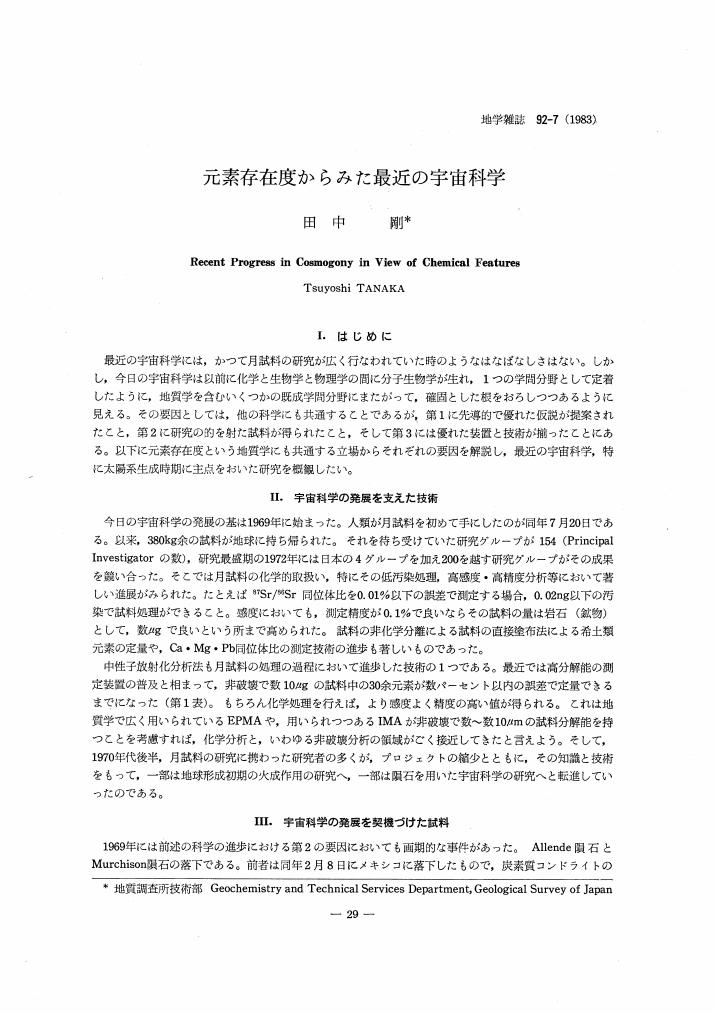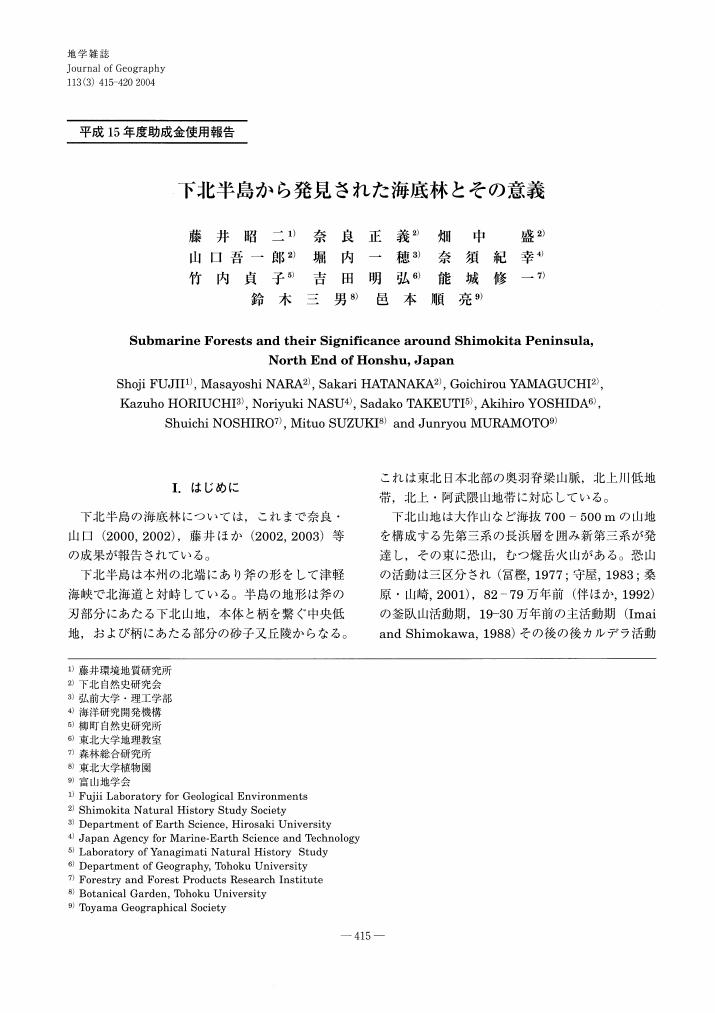1 0 0 0 OA 元素存在度からみた最近の宇宙科学
- 著者
- 田中 剛
- 出版者
- 公益社団法人 東京地学協会
- 雑誌
- 地学雑誌 (ISSN:0022135X)
- 巻号頁・発行日
- vol.92, no.7, pp.469-477, 1984-01-25 (Released:2009-11-12)
- 参考文献数
- 5
1 0 0 0 OA 東京地学協会第14回海外巡検報告「アイスランド地理巡検」
- 著者
- 大山 正雄
- 出版者
- 公益社団法人 東京地学協会
- 雑誌
- 地学雑誌 (ISSN:0022135X)
- 巻号頁・発行日
- vol.120, no.6, pp.1013-1025, 2011-12-25 (Released:2012-03-05)
- 参考文献数
- 22
Iceland is the northernmost country of the world. It is a volcanic island located immediately south of the Arctic Circle. Currently, about 11% of the island is covered with glacial ice. The Mid-Atlantic Ridge, which forms the spreading boundary between the Eurasian and the North American tectonic plates, passes through the middle of the island. It may be said that the natural phenomena in Iceland are formed by three elements: volcanoes, glaciers, and the plate boundary. We visited this geographically fascinating land in August 16-27, 2010. The volcanos and thermal springs are very active along the plate boundary. Most of the lavas are basalts. The thermal water is generally alkaline. The main rivers are braided meltwater rivers flowing from glacial areas. Because the meltwater rivers contain suspended sediments in abundance, the water is gray. A subglacial eruption caused a colossal flood and formed a vast outwash plain. Thermal water is used by geothermal power plants as well as heating systems because even the summers are cold. During this trip, we also observed fractures of the plate boundary, known as “gja” in Iceland.
1 0 0 0 獨佛伊の自動車代用燃料
- 出版者
- Tokyo Geographical Society
- 雑誌
- 地学雑誌 (ISSN:0022135X)
- 巻号頁・発行日
- vol.51, no.6, pp.294-296, 1939
1 0 0 0 OA 地史における土壌圏の発生発展と, その生物環境保全機能について
- 著者
- 松井 健
- 出版者
- 公益社団法人 東京地学協会
- 雑誌
- 地学雑誌 (ISSN:0022135X)
- 巻号頁・発行日
- vol.102, no.6, pp.723-744, 1993-12-05 (Released:2010-11-18)
- 参考文献数
- 41
1 0 0 0 OA ヒマラヤ山脈の上昇のテクトニクス
- 著者
- 酒井 治孝
- 出版者
- 公益社団法人 東京地学協会
- 雑誌
- 地学雑誌 (ISSN:0022135X)
- 巻号頁・発行日
- vol.114, no.1, pp.113-117, 2005-02-25 (Released:2009-11-12)
- 参考文献数
- 8
- 被引用文献数
- 1 1
1 0 0 0 OA 最終氷期のヨーロツパ北西部および北極圏ヨーロッパにおける大陸氷床域
- 著者
- ホッペ グンナー 岩田 修二
- 出版者
- 公益社団法人 東京地学協会
- 雑誌
- 地学雑誌 (ISSN:0022135X)
- 巻号頁・発行日
- vol.90, no.2, pp.62-72, 1981-04-25 (Released:2010-11-18)
ヴァイクゼル氷期 (最終氷期) に広く氷床におおわれたスカンジナビアや北極海の島じまのなかに, 氷におおわれることからまぬがれた地域があったかどうかは, 生物学と地球科学における重要な問題になっている。この問題に加えて, 氷床の大きさと海面変化との関係, 過去の気候条件などの問題を解決するために, ストックホルム大学の自然地理学教室では, 過去25年間にわたって数多くの探険・調査をおこなってきた。氷河擦痕からみて, シェットランド島は, ヴァイクゼル氷期には東側から拡大してきた氷床 (スカンジナビア氷床) によって完全におおわれたことがあった。その後一時期, 島は, スカンジナビア氷床から分離した孤立アイスキャップにおおわれていた。スバールバード周辺では, 隆起汀線から知られた解氷後の地盤隆起と, 氷河の擦痕から, 次のような氷河の変遷があきらかになった。まず, 氷河が拡大し, それぞれの島ごとにアイスキャップをつくり, 次にそれらが合体して大きな氷床になった。最大拡張期には, バレンツ海に氷床の中心があった。その後, 氷河の拡大とは逆の変遷をへて氷河は現在の状態にまで縮小したヴァイクゼル氷期のアイスランドは, 小さなヌナタックをのぞいて, 大陸だなのへりまで氷床におおわれていたことがあきらかになった。これらをまとめると, ノルウェー海をとりまく地域では, ヴァイクゼル氷期には, 現在の海岸線までは確実に, おそらくは大陸だなのへりまで氷床におおわれていたといえる。しかし, バレンツ海の氷床の範囲はまだよくわかっておらず, 1980年におこなわれるイーメル80の調査に大きな期待がかけられている。
1 0 0 0 クックの北極に達せざりし新證據
- 出版者
- Tokyo Geographical Society
- 雑誌
- 地学雑誌 (ISSN:0022135X)
- 巻号頁・発行日
- vol.30, no.5, pp.330-330, 1918
1 0 0 0 OA マントル熱進化モデルの新展開
- 著者
- 千秋 博紀 丸山 茂徳 李野 修士
- 出版者
- 公益社団法人 東京地学協会
- 雑誌
- 地学雑誌 (ISSN:0022135X)
- 巻号頁・発行日
- vol.119, no.6, pp.1215-1227, 2010-12-25 (Released:2011-03-17)
- 参考文献数
- 57
- 被引用文献数
- 6 6
It has long been believed that granite remains on the surface of solid Earth indefinitely due to its low density, hence continents increased in volumes to cover about 30% of the Earth's surface over time. However, recent studies on the accretion history of continents reveals that at least 80% of the granite that ever formed had been subducted into the deep mantle to form “second continents” at the mantle transition zone (410-660 km). These second continents would affect mantle dynamics in two ways. First, as the second continents are gravitationally stable at the depth of the mantle transition zone, they act as a barrier to descending cold slabs. The stagnation of cold slab would be partly due to the pre-existing second continents. Another effect of the second continents on mantle dynamics relates to their chemical component. Because granite is enriched with incompatible elements, including long-lived radiogenic elements K, Th, and U, the second continents act as heat sources in the mantle. In particular, the heat generation of the second continents is a key to understanding the formation-breakup cycle of supercontinents. Granite that piled up beneath a supercontinent during continent accretion would cause thermal instability to form a superplume beneath the supercontinent. A numerical study on the thermal evolution of subducted granite gives the characteristic time scale of thermal instability which is consistent with the lives of supercontinents suggested by geological studies.
1 0 0 0 OA 猪苗代湖盆の形成史
- 著者
- 鈴木 敬治
- 出版者
- 公益社団法人 東京地学協会
- 雑誌
- 地学雑誌 (ISSN:0022135X)
- 巻号頁・発行日
- vol.97, no.4, pp.271-278, 1988-08-25 (Released:2011-02-17)
- 参考文献数
- 13
- 被引用文献数
- 3 2
1 0 0 0 OA 日本における1960–2010年の氷河地形研究
- 著者
- 小野 有五
- 出版者
- 公益社団法人 東京地学協会
- 雑誌
- 地学雑誌 (ISSN:0022135X)
- 巻号頁・発行日
- vol.121, no.2, pp.187-214, 2012-04-25 (Released:2012-05-29)
- 参考文献数
- 133
- 被引用文献数
- 1 4
Fifty years of studies on glacial landforms in Japan between 1960 and 2010 are reviewed from the personal perspective of a researcher who devoted a major part of his life to these studies. The 1960s was a period in which there was a paradigm shift in the history of glacial landform studies in Japan. This resulted from a series of studies by Tomoya Iozawa using aerial photograph interpretation. He was the first researcher to observe and identify all of the glacial landforms in Japan using aerial photographs, and divided them into two groups: the older and more widespread (Yokoo Stage) and the younger and much less widespread (Karasawa Stage). Following his methodology and staging, extensive research was done in the 1970s, and tephrochronological studies revealed that the older and younger stages correspond to MIS 4 and 2 respectively, although MIS 3 glaciation was recognized later in the Hidaka Range, Hokkaido. A researchers union of glacial and periglacial landforms called Kanrei-chikei Danwakai was established in 1972, Proposed and organized by Isozawa and other young students including the author, it stimulated research. In the 1980s, a reconstruction of the mass balance and flows of past glaciers from glacial landforms was attempted by the author and other researchers. This led to the estimation of the Equilibrium Line Altitude (ELA) of former glaciers in Japan. Inventory work and monitoring of perennial snow patches in the Japanese Alps were also begun in the 1980s, and they encouraged studies on the transformation from perennial snow patch to glacier. In addition, the discovery of an ice body at the bottom of Kuranosuke Cirque, Mt. Tateyama, Northern Japanese Alps gave an important hint to estimating the present (topographical) snowline altitude, which could be much lower than the former evaluation determined only from free air temperature. Both the study of perennial snow patches and mapping of the former ELA clarified the importance of precipitation when determining snowline altitude, and the present ELA was estimated at 2970 m just below the peak of Mt. Tateyama (3003 m). Since the 1990s, glacial landform studies became more closely related to global climatic change within the framework of IGBP-PAGES. Glacial fluctuations in Japan in the last glacial period were mainly controlled by monsoon changes and migration of westerlies, which caused a southern migration of the polar frontal zone. Although the glaciers in Japan were small, even in the glacial period, it is now believed that they are an important indicator of climatic changes because they are very sensitive to monsoon and westerly changes.
1 0 0 0 OA 下北半島から発見された海底林とその意義
1 0 0 0 OA サハリンの活断層の分布と概要
- 著者
- 鈴木 康弘 堤 浩之 渡辺 満久 植木 岳雪 奥村 晃史 後藤 秀昭 Mihail I STRELTSOV Andrei I KOZHURIN Rustam BULGAKOV Nikolai TERENTIEF Alexei I IVASHCHENKO
- 出版者
- 公益社団法人 東京地学協会
- 雑誌
- 地学雑誌 (ISSN:0022135X)
- 巻号頁・発行日
- vol.109, no.2, pp.311-317, 2000-04-25 (Released:2010-11-18)
- 参考文献数
- 12
- 被引用文献数
- 3 4
We have prepared a preliminary active fault map of Sakhalin, Russia, based on an interpretation of aerial photographs and satellite images. Major active structures include 110-km-long active faults along the western margin of the Yuzhno-Sakhalinsk Lowland in southern Sakhalin and 120-km-long active faults along the western margin of the Poronaysk Lowland in central Sakhalin. These active faults are parallel to but are located as far as 10 km east of the Tym-Poronaysk fault. Geomorphic surfaces on the upthrown side of the fault are tilting westward, therefore, the faults are considered to be west-dipping low-angle reverse faults. The vertical component of slip rates of these faults are >0.3 mm/yr in southern Sakhalin and 1.0-1.5 mm/yr in central Sakhalin. The net-slip rates could be much greater because the faults are low-angle reverse faults. If these faults rupture along their entire length during individual earthquakes, the earthquakes could be as great as M7.6-7.7. In northern Sakhalin, we have identified a series of right-lateral strike-slip faults, including the 1995 Neftegorsk earthquake fault. The slip rates for these faults are estimated at 4 mm/yr. The right-lateral shear in northern Sakhalin and east-west compression in central and southern Sakhalin may reflect relative plate motion in far-east Asian region.
1 0 0 0 嶋呼三浦君
- 出版者
- Tokyo Geographical Society
- 雑誌
- 地学雑誌 (ISSN:0022135X)
- 巻号頁・発行日
- vol.5, no.6, pp.306a-307, 1893
1 0 0 0 米國第一ノ大天然橋
- 出版者
- Tokyo Geographical Society
- 雑誌
- 地学雑誌 (ISSN:0022135X)
- 巻号頁・発行日
- vol.1, no.8, pp.380-380, 1889
1 0 0 0 光の速さ
- 出版者
- Tokyo Geographical Society
- 雑誌
- 地学雑誌 (ISSN:0022135X)
- 巻号頁・発行日
- vol.37, no.10, pp.614a-614a, 1925
1 0 0 0 マウント、エヴエレスト登山の企圖
- 出版者
- Tokyo Geographical Society
- 雑誌
- 地学雑誌 (ISSN:0022135X)
- 巻号頁・発行日
- vol.15, no.8, pp.643a-644, 1903
1 0 0 0 エトナ山噴火の兆候
- 出版者
- Tokyo Geographical Society
- 雑誌
- 地学雑誌 (ISSN:0022135X)
- 巻号頁・発行日
- vol.4, no.8, pp.387a-387a, 1892
1 0 0 0 OA 流れ山分布の地形学的特徴からみた古羊蹄火山の巨大山体崩壊
- 著者
- 吉田 英嗣
- 出版者
- 公益社団法人 東京地学協会
- 雑誌
- 地学雑誌 (ISSN:0022135X)
- 巻号頁・発行日
- vol.124, no.4, pp.575-586, 2015-08-25 (Released:2015-09-17)
- 参考文献数
- 36
- 被引用文献数
- 1 1
Hummocks are conically shaped mounds, which occur following catastrophic sector collapses, and are mainly observed around volcanoes. Empirical relationships of hummocks proposed by Yoshida et al. (2012) are basically applicable if hummocks now distributed on a debris avalanche depositional area do not have remarkable disturbances due to topographical barriers or modifications after deposition. Using these empirical relationships, the Old Yotei volcano, whose mega-collapse in the Late Pleistocene has not been clarified yet, is examined. The results show that the size-distance relationship of hummocks (N=297), distributed west of the volcano can be expressed by an exponential function as, A=α exp (−β D),where A is the average area of a hummock within a certain span and D is the average distance from the source. For the Old Yotei volcano, the values of coefficients α and β of the fitted curve are 170286.4 and 0.000429, respectively. Based on a geomorphological interpretation of both α and β values, it can be concluded that the collapse volume of the Old Yotei volcano is ca.1.3 km3, and the equivalent coefficient of friction of the debris avalanche is 0.129. The latter also reveals a high probability that the pre-collapse summit of the Old Yotei volcano reached 1700 m a.s.l. Thus, the image of the flank collapse of the Old Yotei volcano has been restored more decisively by the distribution of hummocks.
1 0 0 0 OA 明治六年八月東海道興津川橋の交通量
- 著者
- 淺香 幸雄
- 出版者
- 公益社団法人 東京地学協会
- 雑誌
- 地学雑誌 (ISSN:0022135X)
- 巻号頁・発行日
- vol.46, no.6, pp.292a-295, 1934-06-15 (Released:2010-10-13)
1 0 0 0 「明治丙甲三陸大海嘯之實況」の木版画
- 出版者
- Tokyo Geographical Society
- 雑誌
- 地学雑誌 (ISSN:0022135X)
- 巻号頁・発行日
- vol.108, no.4, pp.Plate1-Plate2, 1999





